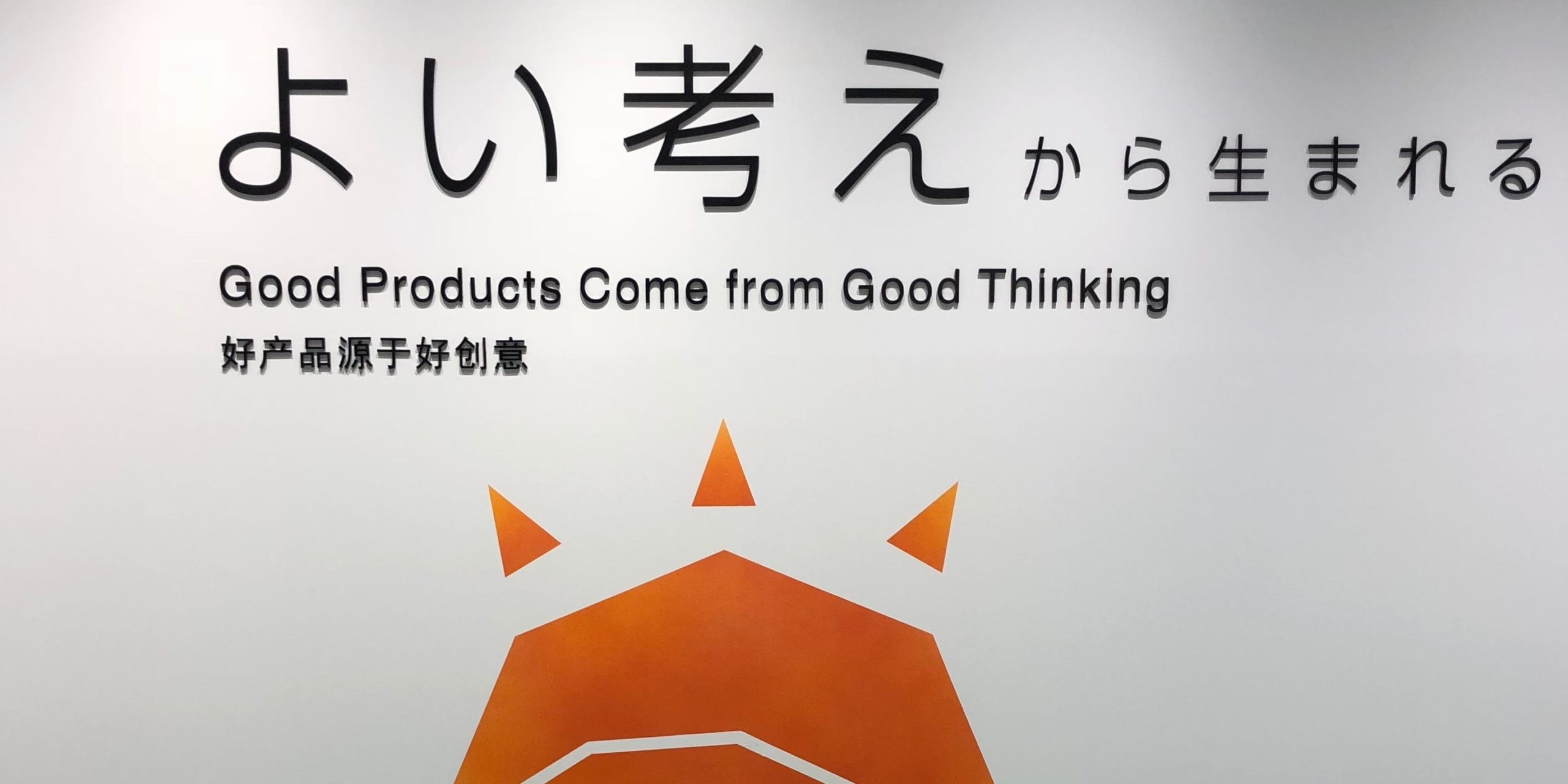
Good Thinking, Good Products
FEATURE – Following a visit to Toyota, the authors strive to challenge popular beliefs and shed a light on the underlying philosophy that has made the Toyota Production System a success for over half a century.
Words: Daryl Powell, Adjunct Professor, Department of Industrial Economics and Technology Management at NTNU and Michael Ballé, lean author, executive coach and co-founder of Institut Lean France
As soon as we entered the shop floor of the Motomachi plant in Toyota city, we noticed a sign towering overhead, carrying six large kanji characters. Translated, they meant: “Good Thinking, Good Products”.
This has been the slogan of Toyota Motor Co. since 1953. Funny, then, that around 65 years later most companies embarking on a lean journey still prefer to try and replicate the tools and techniques developed by Eiji Toyoda and Taiichi Ohno instead of understanding the basic thinking that guided Toyota’s journey and led to the creation of the Just-in-Time and Jidoka concepts. In this article, we reflect on our main takeaways from experiencing the Toyota Production System (TPS) firsthand.
EMPHASIZE CONDITION, NOT CAUSES
Both Just-in-time and Jidoka are designed to encourage management and associates to focus on conditions. For example, the former specifically defines the condition sought – Make what is needed, when it is needed, in the amount needed – while the latter defines the conditions for effective management of processes – When there is an abnormality, machines automatically stop and people suspend their work process. Emphasizing these two fundamental conditions has guided Toyota to the adoption of kanban and andon systems. Only when conditions are not achieved, should one begin to consider causes at the operative level.
There is an inherent focus in lean thinking on studying problems and discovering root causes for the gaps that exist between desired and actual performance. This is great of course, as a robust causal model is just about the only repeatable knowledge we get. But by treating all situations as cause-by-cause problems, one also runs the risk of mistaking the forest for the trees and, as many do when they misunderstand lean, applying front-line management tools (such as looking for causes of daily indicator drift and fixing that) to executive levels of management. This has the potential of overwhelming executives with micro-management tasks and so-called “leader standard work”.
Toyota executives often talk about understanding causes and conditions. For instance, Japanese city streets look very different from our own because there are few sidewalks and no cars parked along the streets. Before purchasing a car, you have to prove you have a place to park it. Although this is declined individually cause by cause, as each person finds a different way to cheat the system (we had fun asking our Japanese friends), the fact is that the condition prevails: no cars are parked in the street. In the same way, customer focus, just-in-time, jidoka and standardized work are conditions to highlight problems and then let people look for specific causes.
Managing conditions at executive level is very different from managing causes at front-line management level – think, for instance, of managing the “mutual trust” condition. In this sense, TPS is really a system of conditions that need to be in place before one can look into causes and achieve effective problem solving.
THINKING AND MOTIVATION, NOT JUST PROCESS ADJUSTMENT
Many organizations opt for a process-centric view of their lean transformation. Process adjustment. Process improvement. However, by observing the production processes at Toyota, one quickly realizes that the thinking and motivation that guides value-adding activities must also adopt a thorough understanding of the technicalities of the product. There is only so much improvement one can make to the process to be better at producing value. Adding more value to the product requires deeper thinking and understanding about its design.
Looking at the Motomachi assembly line in detail, we saw how smooth the standardized work seemed, with seamless movements and each bolt and screw being set in one quick step with no need to position, fiddle and so on. And this smooth standardized work was replicated flawlessly along several models being built in sequence. It really did look like magic. Well-practiced magic!
We also saw that Toyota had on display the shell of a car body, where all machined holes (for the later attachment of parts) were clearly visible. This is where we could see all the careful thinking and experience in designing the body panels so that, in production, parts can be attached in “one breath, one touch”. The design of the car itself determines a large part of the assembly operations, although production does kaizen on the work content to make things easier – for instance getting the tools to work flawlessly or assembling dollies to carry parts around.
Because the shop floor is easier to see than the product development office, many “lean experts” tend to focus exclusively on assembly operations. However, without expanding our scope to include product design one can’t really understand what makes the process tick, and thus where the true intelligence resides to make assembly smooth and seamless. There is far more to lean than standard work, kaizen activities and team daily management rituals.
RESPONSIBILITY FOR KAIZEN LIES WITH THE DEPARTMENT
It is commonly believed that it is the work of management, in a top-down style of leadership, to authorize and instruct much of the improvement that takes place in a lean organization. However, Toyota maintains a bottom-up approach to kaizen, identifying improvement opportunities and communicating them up through line management, where business process liaisons become involved to engage other departments in the improvement activities.
One of the great surprises of our visit to Motomachi was that the Toyota experts we talked to. Old timers like Harada-san, who once worked with Taiichi Ohno and eventually became president of the Taiwan plant, and Takao Sakai, who is au fait with current Toyota practice, were adamant that there was in fact very little exchange between production and engineering – with engineering taking place across the highway from the factory, both buildings divided by Japan National Route (NR) 248. And yet, as previously discussed, a lot of kaizen ideas had found their way into the product design to make cars easier to assemble.
One possible answer to this confounding puzzle seems to be the systematic use of liaison staff – taking high potentials from engineering to sit in production as resident engineers and, vice-versa, taking experienced production managers to be part of the Chief Engineer’s core team.
Takao Sakai explained to us that to understand Toyota’s success and unorthodox practices one has to see the talent management system that is the hidden side of the iceberg. Cross-departmental communication doesn’t happen through systems or meetings but by a rigorous policy of rotating people in key jobs so that that they learn from each other. Once again, we see that collective learning at Toyota is engineered from individual learning: knowledge is incarnate and has no meaning out of context, or outside the mind of an individual.
“Good thinking, good products” is indeed emphasized from the large board hanging in the plant to the welcome pen distributed by Toyota. Unfortunately, as we have traditionally been taught to look at the process as “people-free”, the extent to which Toyota considers its success as the sum of individual characteristics such as talent, passion, ingenuity, teamwork (an individual skill), creativity, courage and so on is always surprising and easy to miss.
PAY ATTENTION TO LEARNING CURVES
Finally, it was fantastic to see so many examples in Nagoya’s Toyota Commemorative Museum of Industry and Technology of how the company has exploited learning curves for sustainable continuous improvement of various vehicle components over the years – including radiators, starter motors, batteries, alternators and fuel injection systems. All too often, organizations nowadays seek to jump to the next disruptive innovation, paying little or no regard to the learning that can be generated from previous generations of products.
Continuous innovation is of course a fundamental requirement for many organizations to survive in the competitive marketplaces of the 21st century, but it must be combined with continuous improvement in order to promote sustained lean growth.
It’s easy to see Toyota’s just-in-time supply chain as a way to use logistics to drive productivity through its network of suppliers – most situated around Toyota City within a 100-mile radius. But the conditions necessary to maintain such a tight connection with key suppliers – we’re talking about one pickup of all parts every 20 minutes – are the same that allow for much greater cooperation in design and development. In the museum, we saw how the total value of the car is engineered both by value analysis (improvements while the parts are in production) and value engineering (improvement at the design stage) according to explicit learning curves.
One of the enduring puzzles of lean is how a sum of local improvements can translate into overall competitive quality, flexibility and cost advantage. The displays in the Toyota museum clearly demonstrate the progressive approach to car engineering and the integration of improvements at each design cycle by a careful study of interface standards. The evolution of several key automobile functions, such as engines or steering, are highlighted in the displays, with explanations on the evolution of the corresponding production processes. This evolutionary approach to products, nourished by learning curves pursued by each functional department, paint a stark picture of Toyota as a deliberate, steadfast, learning organization where the lean system of continuous development of people delivers a continuous flow of improvement and changes keeping cars both innovative (think Prius or Mirai) and amazingly robust – thus sidestepping the usual trade-off we currently see at Tesla between radical innovation and product quality.
“Good thinking, good products” is not an idle slogan – just as “to make products, first we make people”. The deeper lesson here is that lean is not a set of organizational techniques to extract more value from operational processes, as it is often interpreted in many firms, but a set of principles to create the conditions to think more deeply and learn by constantly trying to improve things and seek a better way, small step by small step. Indeed, as we asked our tour guide about what kind of kaizen events Toyota conducted, she had trouble understanding the question before finally giving us a detailed explanation of how Toyota elicited individual suggestions from every employee.
Indeed, when Eiji Toyoda visited Ford in 1950, he came back with a leaflet of Ford’s suggestion system and set up Toyota’s own suggestion system, which was launched in 1953 with an enduring slogan to inspire employee participation. Guess what the slogan was!
THE AUTHORS

Daryl Powell is Lean Programme Manager - Subsea Division at Kongsberg Maritime and Adjunct Professor in the Department of Industrial Economics and Technology Management at NTNU in Norway.
Michael Ballé is co-founder of the Institut Lean France. He is a best-selling author and an engaging speaker, and managing partner of ESG Consultants. He also works as a lean executive coach in various fields. His latest book, The Lean Strategy (co-authored with Dan Jones, Jacques Chaize and Orry Fiume) is available here.
Read more


FEATURE – This article explores the integration of lean leadership behaviors with digital tools to achieve sustainable performance improvement in modern organizations.


FEATURE – What if we ran our production schedule to time instead of quantity? While creating overproduction, running to time is a temporary first step to establish levelled production with fixed repetitive cycles.




CASE STUDY – Faced with complex logistics and customer complaints, a small deli and butchery in Botswana saw in lean a way to bring the business back from the brink. The philosophy didn’t fail them.

